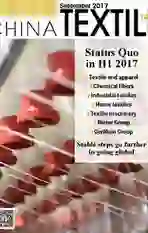Dear readers
2017-10-16
A new investment ceremony is prominently spotlighted on August 28th as a brand new building facaded with clean and bright glass wall of a mammoth structure stands magnificently against a gray sky. The red signage stuck in the upper middle of the modern structure is the logo for Shandong RUYI Corporation, an idolized big shot in Chinese textile industry for its amazing business revenues that approach to 100 billion dollars and for its marvelous nation-wide and global investments that set the company on a fast track to be a transnational player featuring state-of-the-art technology and upend fashion being vertically-integrated from farm to shopping street.
The logo is a typical Chinese Knot of Good Luck, an auspicious hand-braided ornament, often red in colour, represents exactly the same notion of the companys name RUYI. The launching ceremony of National Spinning Engineering Technology Centre, National Enterprise Technology Centre, National Industrial Design Centre and RUYI Science and Fashion Centre, coupled with its 45th anniversary of the foundation of the company, falls on July 7th as per Chinese lunar calendar, the Chinese Valentines Day based on its legendary love story, signifying good luck and best wishes to the event on this romantic day.
Chinese textile investment ramps up by 9.1 percent in the first 6 months this year, a steady improvement after its slowdown last year, but still far from its peak growth by 36.33 percent in 2011, stepping up its transformation from low efficient growth model to innovation-driven development characterizing scientific and technological advancement, fashion steering and green production, which is now a new label for the textile industry being proudly advocated. The latest economic statistics show the increased investment goes to the capacity building aimed at enhancing technological level of physical property, operators quality and object of work, three important components of productivity that is to be elevated if the industry continues to stay competitive against new business environment.
Referring to the textile industrys new label for science & technology, fashion and greenness, the most awesome progress was made especially in the sustainability drive that swept across the country for many years that witnessed a sharp drop of water consumption and effluents during the 12th Five-Year Program Period (2011-2015) on account of the dyed fabric production that was reduced from around 60 billion meters in 2011 to about 50 billion meters more than a year ago. According to the statistics from Ministry of Environment Protection, it surveyed 10,891 sizable companies in the textile industry to come up with the report that these companies consumed 8.65 billion tons of water in 2014. representing 2.36 percent of national total industrial water consumption, and 8.1 percent of the national fresh water inlet for 3.14 billion tons taken into textile processing line.endprint
Reducing water consumption is part of the full-packaged endeavors for clean and green production, the challenge remains to fight contaminants in effluents that must measure up to the very demanding standards by the state-of-the-art waste-water treatment technology and plant. Off the quality, the dyeing and printing houses must shut down as is stipulated in the governmental regulations and rules, such as [[Effluents Standards for Waste Water Contaminants in Textile Dyeing and Printing Industry]] (GB4287-2012) which adds total allowed amount of antimony in the effluent to this regulation in 2015,[[Action Plan for Water Pollution Prevention]] and [[Standards for Air Emissions in Dyeing and Printing Industry]].
With this, the dyeing and printing houses stays surviving of the fittest, which might be the very rules that must be observed and stuck to, if the whole textile industry is running in black to be profitable, and running in green to be sustainable.
ZHAO Hong, Editor-in-Chief
September, 2017endprint
杂志排行
China Textile的其它文章
- Cotton Market Fundamentals&Price Outlook
- HKTDC Export Index shows exporters’confidence slip in Q3
- A specific solution for each quality need
- ITMA 2019 garment sector zooms in on automation to help manufacturers accelerate productivity and efficiency
- Strong potential The big & tall men’s market
- Wool footwear steps up to the mark at Spinexpo
